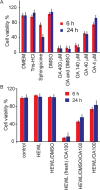HEWL interacts with dissipated oleic acid micelles, and decreases oleic acid cytotoxicity
- PMID: 30794655
- PMCID: PMC6386356
- DOI: 10.1371/journal.pone.0212648
HEWL interacts with dissipated oleic acid micelles, and decreases oleic acid cytotoxicity
Erratum in
-
Correction: HEWL interacts with dissipated oleic acid micelles, and decreases oleic acid cytotoxicity.PLoS One. 2019 Aug 22;14(8):e0221704. doi: 10.1371/journal.pone.0221704. eCollection 2019. PLoS One. 2019. PMID: 31437263 Free PMC article.
Abstract
Senile plaques are well-known hallmarks of Alzheimer's Diseases (AD). However, drugs targeting tangles of the protein tau and plaques of β-amyloid have no significant effect on disease progression, and the studies on the underlying mechanism of AD remain in high demand. Growing evidence supports the protective role of senile plaques in local inflammation driven by S100A9. We herein demonstrate that oleic acid (OA) micelles interact with hen egg white lysozyme (HEWL) and promote its amyloid formation. Consequently, SH-SY5Y cell line and mouse neural stem cells are rescued from OA toxicity by co-aggregation of OA and HEWL. Using atomic force microscopy in combination with fluorescence microscopy, we revealed that HEWL forms round-shaped aggregates in the presence of OA micelles instead of protofibrils of HEWL alone. These HEWL amyloids act as a sink for toxic OA micelles and their co-aggregate form large clumps, suggesting a protective function in amyloid and OA cytotoxicity.
Conflict of interest statement
The authors have declared that no competing interests exist.
Figures




Similar articles
-
Attenuation of lysozyme amyloid cytotoxicity by SPION-mediated modulation of amyloid aggregation.Int J Biol Macromol. 2015 Mar;74:439-46. doi: 10.1016/j.ijbiomac.2014.12.040. Epub 2015 Jan 3. Int J Biol Macromol. 2015. PMID: 25562831
-
Sodium louroyl sarcosinate (sarkosyl) modulate amyloid fibril formation in hen egg white lysozyme (HEWL) at alkaline pH: a molecular insight study.J Biomol Struct Dyn. 2018 May;36(6):1550-1565. doi: 10.1080/07391102.2017.1329097. Epub 2017 May 28. J Biomol Struct Dyn. 2018. PMID: 28490248
-
Elucidating the binding and inhibitory potential of p-coumaric acid against amyloid fibrillation and their cytotoxicity: Biophysical and docking analysis.Biophys Chem. 2022 Dec;291:106823. doi: 10.1016/j.bpc.2022.106823. Epub 2022 May 11. Biophys Chem. 2022. PMID: 35868967
-
[Development of SPECT Probes for In Vivo Imaging of β-Amyloid and Tau Aggregates in the Alzheimer's Disease Brain].Yakugaku Zasshi. 2017;137(11):1361-1365. doi: 10.1248/yakushi.17-00156. Yakugaku Zasshi. 2017. PMID: 29093372 Review. Japanese.
-
The formation of amyloid fibrils from proteins in the lysozyme family.Curr Protein Pept Sci. 2007 Dec;8(6):537-57. doi: 10.2174/138920307783018659. Curr Protein Pept Sci. 2007. PMID: 18220842 Review.
Cited by
-
Surface-Directed Structural Transition of Amyloidogenic Aggregates and the Resulting Neurotoxicity.ACS Omega. 2020 Feb 6;5(6):2856-2864. doi: 10.1021/acsomega.9b03671. eCollection 2020 Feb 18. ACS Omega. 2020. PMID: 32095707 Free PMC article.
-
Correction: HEWL interacts with dissipated oleic acid micelles, and decreases oleic acid cytotoxicity.PLoS One. 2019 Aug 22;14(8):e0221704. doi: 10.1371/journal.pone.0221704. eCollection 2019. PLoS One. 2019. PMID: 31437263 Free PMC article.
References
-
- Tan J, Town T, Paris D, Mori T, Suo Z. Microglial Activation Resulting from CD40-CD40L Interaction After β-Amyloid Stimulation. Science. 1999; 286:2352–2355. - PubMed
Publication types
MeSH terms
Substances
LinkOut - more resources
Full Text Sources
Miscellaneous

